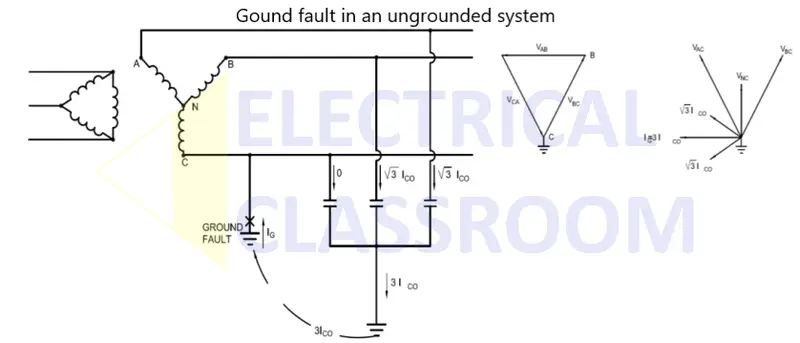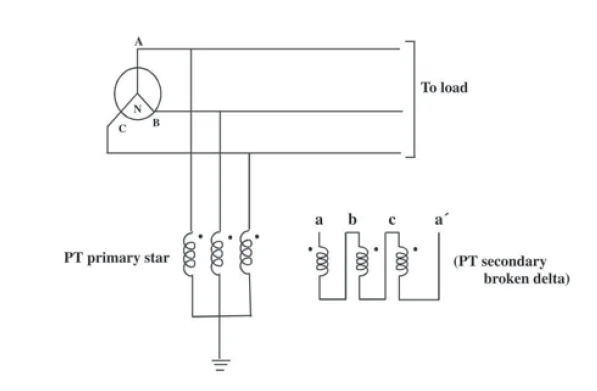An electrical system that is not intentionally connected to the ground is known as an ungrounded system. Even though the system is not connected to the ground, there exists a connection to the ground due to the presence of capacitances between the live conductors and the ground. Therefore the so-called ungrounded system is actually a capacitance grounded system due to the presence of the distributed capacitance from the system conductors to the ground.
Even though a capacitance ground exists, it has a very less effect on the system under normal working conditions and hence is disregarded.

Also read: Types of Grounding
The behavior of an ungrounded system during faults
Under normal conditions, the line-to-ground capacitances have no effect on the system. The capacitive currents and phase-to-ground voltages are equal and displaced at 120 ° C from each other. This makes the system fully balanced.
Let us assume that phase C is in contact with the ground. Under this condition, the current flowing from the other two conductors through the capacitance, to the ground increases by a factor of root 3. And no current flows through the capacitor of phase C. Also, the line-to-ground voltages of the other two phases shall be displaced by 600. This situation can damage equipment connected to the system and damage the winding insulation of motors and transformers.
The vectorial sum of the capacitive charging current to ground shall be three times the original charging current per phase which is denoted by 3Ico in the diagram. The fault current, Ig, flowing from phase C to the ground, leads the original line-to-neutral voltage by 90°.
Effect of ground faults in an ungrounded system
The transient currents that occur in the healthy phases of an ungrounded system might exceed the normal line-to-ground voltages. When the first fault is left uncleared for a longer time, the second ground fault may occur on one of the other two conductors due to the overstress by high voltage over their insulators.
Transient voltages occurring due to restriking or intermittent ground faults can develop overvoltages up to 1200V with respect to the ground. These transients are a result of a resonant condition established between the inductive reactance of the system and the line-to-ground capacitance. It is possible that such high voltages can damage equipment connected to the system and damage the winding insulation of motors and transformers. Therefore, if the ground fault in an ungrounded system is not cleared immediately it will cause much larger damage to the system.
Ground fault detection in an ungrounded systems
The conventional method of detecting a fault in an ungrounded system is the three-bulb method. Three bulbs, one connected between each phase and the ground. Under normal conditions, these bulbs glow uniformly. In the event of a ground fault, the bulb connected to the faulted phase is extinguished and the rest of the bulbs glow brighter. Another technique uses three voltage transformers in a wye-open delta configuration with their neutral of wye grounded. A voltage relay is connected to the open delta secondary of the transformers, which can operate an alarm circuit on the occurrence of a fault.
The ground fault detection in an ungrounded system is a time-consuming one. The transient restriking voltage and the difficulty in sensing the faults make the ungrounded systems no longer recommended.
Advantages of an ungrounded system
- The ensuing currents from ground faults are very low that they don’t immediately harm the system. As a result, the system can function without interruption, which may be crucial if an outage would results in costly production losses or life-threatening catastrophes.
- There is no additional grounding cost involved.
Disadvantages of an ungrounded system
- Tracing the exact fault location is difficult in an ungrounded system.
- A ground fault results in the flow of capacitive current at the point of fault. This may cause repeated arcing and build-up of excessive overvoltages with respect to the ground.
- The ground fault in one phase may lead to ground fault in other phases if the fault is left unresolved.
- The system could be affected by the transients caused by lightning.

